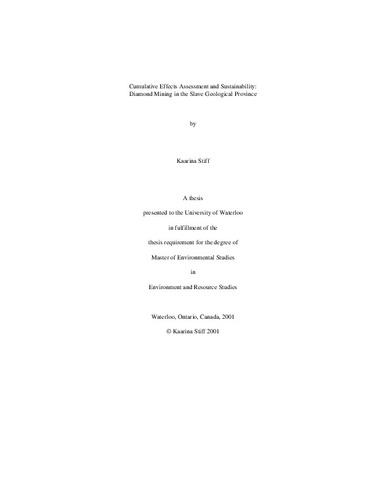| dc.contributor.author | Stiff, Kaarina | en |
| dc.date.accessioned | 2006-08-22 14:09:03 (GMT) | |
| dc.date.available | 2006-08-22 14:09:03 (GMT) | |
| dc.date.issued | 2001 | en |
| dc.date.submitted | 2001 | en |
| dc.identifier.uri | http://hdl.handle.net/10012/986 | |
| dc.description.abstract | The pace of development in Canada's North has renewed concerns about the potential cumulative effects of increasing industrial growth on fragile northern ecosystems. Recent developments in the diamond industry in the Slave Geological Province have highlighted the potential additive and synergistic effects of such development. For example, Aboriginal communities are worried about the health of the Bathurst caribou herd, which is considered central to their way of life. This concern is compounded by the lack of integration of environmental assessment and planning efforts, which could serve to better protect the environment. This research considers the challenges associated with the assessment of cumulative effects, and various approaches to meet these challenges. Diamond mining in the Slave Geological Province, including the BHP and Diavik diamond mines, is used as a case study. Four sustainability-based criteria are developed to evaluate the past and existing situation in the diamond region, and to form the basis for recommendations that would contribute to a more holistic approach to integrating cumulative effects considerations into environmental assessment and regional planning. The analysis demonstrates that although several mechanisms are currently in place to assess cumulative environmental effects, no single initiative fully meets each of the four criteria. However, existing tools can be used and supplemented to identify appropriate response options. The sustainability-based criteria developed here can contribute to further research on cumulative effects assessment and sustainability. The sustainability-based criteria developed here can be adopted for other case studies, to identify strengths and weaknesses, and to develop case specific recommendations for a more holistic approach to integrating cumulative effects considerations into environmental assessment and regional planning. This examination of how cumulative effects assessment has been approached in the Slave Geological Province also provides insight into the broader implications of regional cumulative effects management. | en |
| dc.format | application/pdf | en |
| dc.format.extent | 672955 bytes | |
| dc.format.mimetype | application/pdf | |
| dc.language.iso | en | en |
| dc.publisher | University of Waterloo | en |
| dc.rights | Copyright: 2001,
Stiff, Kaarina. All rights reserved. | en |
| dc.subject | Environmental Studies | en |
| dc.subject | environmental assessment cumulative effects sustainable development | en |
| dc.title | Cumulative Effects Assessment and Sustainability: Diamond Mining in the Slave Geological Province | en |
| dc.type | Master Thesis | en |
| dc.pending | false | en |
| uws-etd.degree.department | Environment and Resource Studies | en |
| uws-etd.degree | Master of Environmental Studies | en |
| uws.typeOfResource | Text | en |
| uws.peerReviewStatus | Unreviewed | en |
| uws.scholarLevel | Graduate | en |

